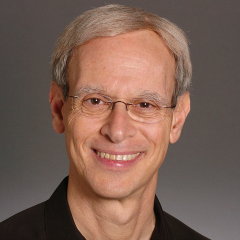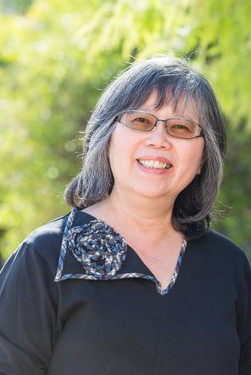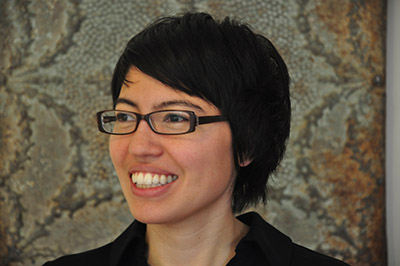In a year when John Black, Cathy Chase and Teachers College hosted the annual Subway Summit on Cognition and Education Research, it’s no surprise that the prevailing theme was interactive learning.
The Summit – which gathers students and faculty from four New York City universities – Fordham University, New York University, The City University of New York Graduate Center, and TC – is by nature an interactive event. But Black, TC’s Cleveland E. Dodge Professor of Telecommunications & Education and Director of the College’s Institute for Learning Technologies, is particularly renowned for his work on grounded cognition, or learning rooted in sensory experience, while Chase, Assistant Professor of Cognitive Studies, explores the impact of instructional design on student learning, transfer and motivation, largely in the context of science education.
This year’s event, held in TC’s Smith Learning Theater and hosted by the Office of the Vice Provost and the Department of Human Development, featured keynote addresses by two internationally renowned educational researchers – Robert Siegler, who has just joined Teachers College as the Jacob H. Schiff Foundations Professor of Psychology & Education, and Michelene (Micki) Chi, Foundation Professor and Dorothy Bray Endowed Professor of Science and Teaching at Arizona State University.

COMMON DENOMINATOR Siegler spoke about why American students struggle with fractional addition.
Siegler, previously the Teresa Heinz Professorship of Cognitive Psychology at Carnegie Mellon University, spoke about his core area of expertise – the development of mathematical thinking, and the reasons why U.S. students trail their peers in Asia and Europe in the understanding of basic fractional arithmetic. (Hint: it has something to do with the fact that teachers themselves often don’t understand fractions – and that textbooks pose problems with little connection to the real world. Read an interview with Siegler to find out more.
Chi is credited with developing the widely-regarded “ICAP framework of Cognitive Engagement,” which posits four modes of learning: Interactive, Constructive, Active, and Passive. Interactive learning involves collaboration with a peer to build upon one another’s insights and statements, producing a broader perspective than either learner could generate alone. Constructive learning is generative – the student makes an inference based on information he or she has been given, or makes a prediction based on an understanding of the variables involved. Active learning takes place when the learner manipulates something as part of the learning process – for example, by taking notes, participating in a discussion, or using technology. Passive engagement describes simply paying attention, but not doing anything.
Everyone wants kids to be more involved in open-ended complex problem solving where there’s not an obvious way to solve the problem. But students also need guidance on how to do it without quelling their exploratory instinct.”
– Cathy Chase
As Chi discussed, the ICAP hypothesis is that interactive engagement will yield greater learning – not so much in terms of knowledge recall as in the form of deep understanding of subject matter, which implies an ability to apply learning in different contexts.

EASIER SAID, BUT BETTER DONE Chi believes that interactive engagement will yield deeper understanding of subject matter -but has found that that teachers struggle in creating constructive and interactive lessons.
Chi reported on her work to determine whether teachers can be trained to design lessons that reflect the ICAP framework. Her overwhelming finding thus far is that teachers need a great deal of guidance in creating constructive and interactive lessons.
“Everyone wants kids to be more involved in open-ended complex problem solving where there’s not an obvious way to solve the problem,” said Cathy Chase. The challenge, she says, is that “students also need guidance on how to do it without quelling their exploratory instinct.”
Interactive learning was, in fact, a common focus for many of the 26 research projects and posters presented at the conference.

STAYING GROUNDED Black is an authority on learning rooted in sensory experience.
A joint project directed by Jan Plass, NYU’s Paulette Goddard Professor in Digital Media and Learning Sciences, and Associate Professor Bruce Homer, the Director of the CUNY Children’s Interactive and Learning Development Lab, detailed how video games can increase the executive function of students by inhibiting their absorption of irrelevant information.
A TC group led by Black presented three papers and a poster on games to help students learn financial literacy, physics and the coding of computers.
This is a way for students to get experience, and part of that experience is to explain your research in 13 minutes.”
– John Black
TC doctoral student Laura Malkevitch presented on the topic of student learning from engineering tasks, including maker space activities and robotics clubs. These activities are powerful assets in engaging student interest, but carry the risk of over-emphasizing “building something that works” at the expense of creating a true understanding of underlying scientific principles. Malkevitch has explored the effectiveness of co-tasking students engaged in these projects with a learning goal, such as positing a rule based on a building experience.
Not all the presentations focused on academic learning. Doctoral student Ilya Lashevsky spoke about his research on an online intervention he has created to help people better understand and respond to others’ emotions. And not all involved technology: Doctoral student Daniel Lerman presented on a game called “Yes, but…”, developed by TC Professor of Psychology & Education Deanna Kuhn, which (for now, at least) centers on presenting high school students with a statement written on an ordinary piece of paper. The exercise is intended to develop critical thinking skills by asking students to prove or disprove an assigned premise – e.g., “cigarettes cause cancer” – through the use of deductive reasoning and research.

LEARNING BY DESIGN Chase explores the impact of instructional design on student learning, transfer and motivation.
Launched 11 years ago by Fordham, the Summit now rotates annually among the four participating universities. This was the second time that TC hosted the event.
“I was very impressed by the quality of the student presentations and their ability to connect with a broad audience,” said Chase
“This is a way for students to get experience, and part of that experience is to explain your research in 13 minutes,” said Black. “It also gives us a chance to see what everyone else is up to. Otherwise, we’d all be in our silos.”
